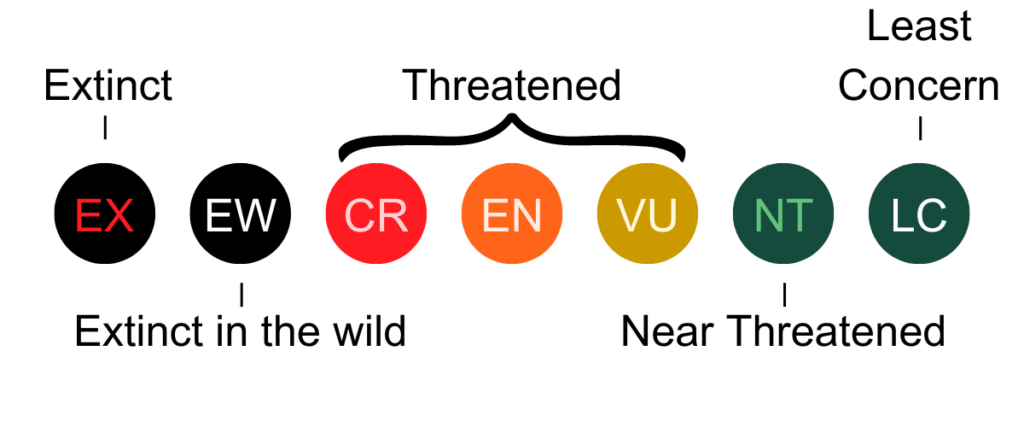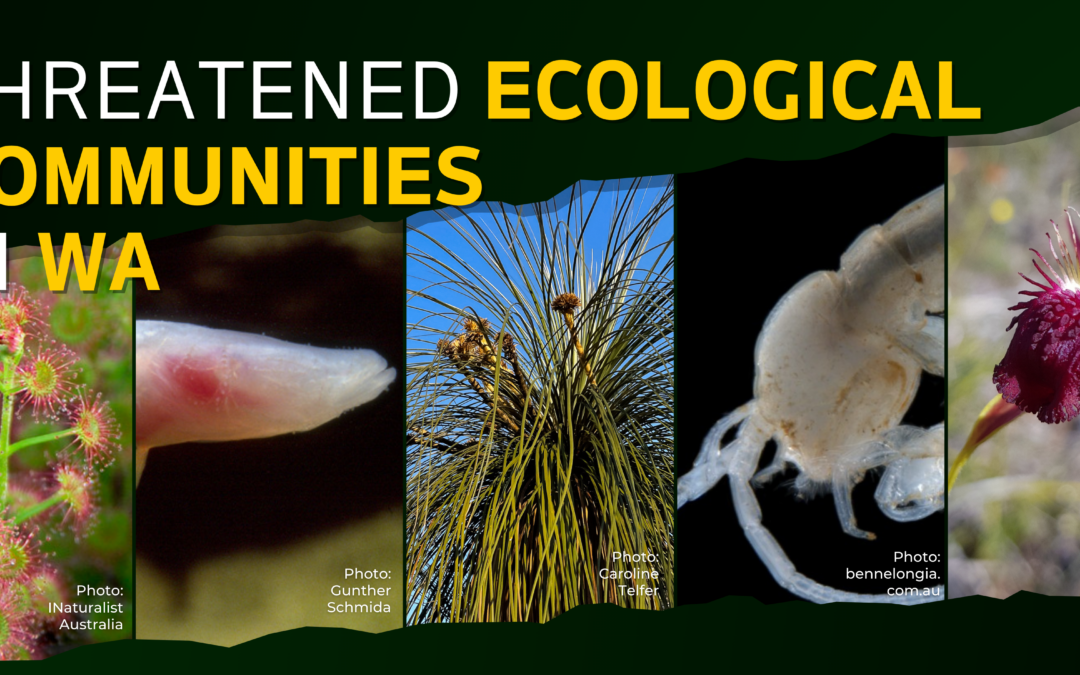An ecological community is a group of distinct species living in the same habitat, which interact with each other (Cornell, 2013). These interactions are unique to the specific community, such that no two communities are entirely the same. However, when they are at risk (Newton, 2021) or are geographically restricted, they may be classified as a Threatened Ecological Community (TEC) (DBCA, 2023a).

Source: (George, 2016)
TECs within Western Australia are protected under the Biodiversity Conservation Act 2016 (BC Act) according to their conservation status, vulnerable, endangered or critically endangered. The BC Act defines the conservation status of a TEC using the International Union for Conservation of Nature’s (IUCN’s) Red List of Ecosystems criteria (DBCA, 2023b). The criteria evaluate the level of risk for the community to collapse by compiling and validating available data with further fieldwork, if required (IUCN , 2023). Under this system, the Camerons Cave Troglobitic Community, located near Exmouth, is considered critically endangered (Government of WA, 2023). This was due to the community containing eight species only found within the cave, including Stygiochiropus peculiaris (Camerons cave millipede) and vulnerable species, Milyeringa veritas (Blind gudgeon) (Government of WA, 2023).


Source: (Fishes of Australia, 2023)
Some TEC in Western Australia can be protected under both the BC Act and Commonwealth Environment Protection and Biodiversity Conservation Act 1999 (EPBC Act). This is the case for Corymbia calophylla – Kingia australis woodlands (Figure 4) on heavy soils of the southern Swan Coastal Plain TEC (DCCEEW, 2023a). Under the BC Act, it is considered critically endangered due to containing six priority species and the critically endangered Caladenia heugelii (Grand Spider orchid) (DCCEEW, 2023b). While under the EPBC Act, it is an endangered TEC with the endangered Grand Spider orchid. Regardless of the difference in conservation status for the TEC, recovery plans have been developed to improve the TEC’s health (DCLM, 2000) (DEC, 2011).

Source: (Urban Bushland Council WA, 2023)
Are there other Ecological Communities of note in WA?
Some ecological communities while not currently at risk of collapse may be poorly known. These communities may be classified as a Priority Ecological Community (PEC) (DBCA, 2023a). Similar to TECs, PECs are also categorised, but it is based on their conservation priority for research from P1 to P5 (DBCA, 2023c). The lowest priority is for P4 and P5 PECs as they are regularly monitored and part of a specific conservation program, respectively, but will become threatened if these efforts stopped (DBCA, 2023c). For P3 PECs, some information has been gathered, such as existing threats however, they are still considered inadequately defined. While P1 and P2 PECs have the highest priority due to the limited number of occurrences and range of occurrences sighted (DBCA, 2023c).

Source: (Fierce Flora, 2020)
Communities considered P1 PECs are those with roughly five known occurrences or the sighted range is within 100ha (DBCA, 2023c). The occurrences are also under threat due to their size or their location to cleared areas for agriculture, urban development or mine sites. P1 PECs include the Central Whicher Scarp Jarrah woodland and the stygofaunal community of the Bungaroo aquifer (DBCA, 2023d). The Jarrah woodland contains a large abundance of rare southern flora including Drosera stolonifera (Leafy Sundew) (Figure 5). Similarly, the Bungaroo aquifer has a unique group of aquatic subterranean fauna such as eels, snails and other stygofauna (DBCA, 2023d).
How to List TECs
Under the BC Act, the public is able to make a nomination for the inclusion, amendment or removal of a TEC to the Minister. This is done through nominees providing information on the biology, ecology, threats and necessary management systems for the TEC’s conservation status to be assessed (DBCA, 2018).
If the Minister finds that a nomination was made for a joke or senselessly, it can be rejected without notification to the nominee (BC Act). When, a reasonable nomination is made then the Minister passes it to the Threatened Ecological Communities Scientific Committee for scientific advice (DBCA, 2018). This advice is primarily focused on determining whether the nominee provided enough information for the community to be listed or if it should be deferred until more is gathered. The nominee is then given notice about the Minister’s decision, those rejected are accompanied by reasons for the rejection (BC Act).
How Does Listing Protect TECs?
For proposed activities within a TEC area, extra consideration is provided to ensure it is not impacted (DBCA, 2023a). For instance, clearing of native vegetation should not occur if part of a TEC will be affected (Environment Protection Act 1986) unless approved under the BC Act. This provides greater protection as it ensures smaller species such as non-flowering plants, invertebrates and micro-organisms, and their interactions are protected (DBCA, 2023a). The process is then more cost effective and efficient at protecting non-threatened species so they don’t become threatened in the future.
Determination of TECs also leads to information from surveys and environmental reports being collated by DBCA into a database (DBCA, 2023e). When it finds that a TEC is present on private property, the landowner is notified (DBCA, 2023b). However, if the landowner finds that the TEC is unlikely on their property, the Threatened Ecological Communities Scientific Committee will be contacted to review the available knowledge to make a decision (DBCA, 2023b). The database also allows for companies or the public to request for a search of an area to determine if a TEC is present (DBCA, 2023e).
Relevance to Landowners
Landowners are obligated to not modify/clear/damage/harm a TEC without approval under the BC Act (DMIRS, 2020). To obtain approval to modify/clear/damage/harm, the landowner will need to described the activities that will impact the TEC, described the TEC involved, document the any avoidance or mitigation measures they plan to adopted (DBCA, 2023g). Only when the chief executive officer of the Department (CEO) has approved the application, can modification occur (BC Act). It should be noted that if the modification/harm is to mitigate the risk of bush fires on non DBCA managed land, this can occur without approval (DBCA, 2023f). DBCA should be notifies as soon as possible after the impact occurs. Integrate Sustainability Pty Ltd understands the importance of ecological communities in Western Australia and how they can become a Threatened or Priority Ecological Community, so if your company wants more information on PECs, what activities modify TECs and when authorisation to modify is necessary, please call us on 08 9468 0338 or email us at enquiries@integratesustainability.com.au
References
Cornell, H. (2013). Diversity, community/regional level. In S. Scheiner, Encyclopedia of Biodiversity (Second Edition) (pp. 595-607). Newark: Academic Press. doi:https://doi.org/10.1016/B978-0-12-384719-5.00035-6.
DBCA. (2018). Ministerial Guideline Number 1: Procedures for making and assessing public nominations for listing species or communities as threatened species or threatened ecological communities, and for listing key threatening processes.
DBCA. (2023a). Threatened ecological communities. Retrieved from https://www.dbca.wa.gov.au/wildlife-and-ecosystems/threatened-ecological-communities
DBCA. (2023b). Frequently asked questions: Western Australia’s threatened ecological communities. Retrieved from https://www.dbca.wa.gov.au/sites/default/files/2023-07/Frequently%20Asked%20Questions%20-%20Western%20Australia’s%20Threatened%20Ecological%20Communities.pdf
DBCA. (2023c). Conservation category definitions for Western Australian ecological communities. Department of Biodiversity, Conservation and Attractions.
DBCA. (2023d). Priority ecological communities for Western Australia version 35.
DBCA. (2023e). Threatened species and communities database searches. Retrieved from https://www.dbca.wa.gov.au/management/threatened-species-and-communities/threatened-species-and-communities-database-searches
DBCA. (2023f). Authorisation to modify a threatened ecological community. Retrieved from https://www.dbca.wa.gov.au/management/threatened-species-and-communities/protections-and-approvals/authorisation-modify-threatened-ecological-community
DBCA. (2023g). Guidance note: Section 45 Ministerial authorisation for modification of an occurrence of a threatened ecological community.
DCCEEW. (2023a). Corymbia calophylla – Kingia australis woodlands on heavy soils of the Swan Coastal Plain. Retrieved from http://www.environment.gov.au/cgi-bin/sprat/public/publicshowcommunity.pl?id=17
DCCEEW. (2023b). Caladenia heuglii: King spider orchid, grand spider orchid, rusty spider orchid. Retrieved from http://www.environment.gov.au/cgi-bin/sprat/public/publicspecies.pl?taxon_id=7309
DCLM. (2000). Corymbia calophylla – Kingia australis woodlands on heavy soil: Interim recovery plan.
DEC. (2011). Corymbia calophylla – Kingia australis woodlands on heavy soil: Interim recovery plan.
DMIRS. (2020). Threatened species and ecological communities. Retrieved from https://www.wa.gov.au/organisation/department-of-mines-industry-regulation-and-safety/threatened-species-and-ecological-communities
Fierce Flora. (2020). Drosera stolonifera species profile. Retrieved from https://www.fierceflora.com/drosera-stolonifera/
Fishes of Australia. (2023). Cave Gudgeon, Milyeringa veritas Whitley 1945. Retrieved from https://fishesofaustralia.net.au/home/species/1172
George, A. (2016). IUCN classification:Critically endangered, endangered and vulnerable. Retrieved from ClearIAS: https://www.clearias.com/iucn-classification-critically-endangered-endangered-and-vulnerable/
Government of WA. (2023). Biodiversity Conservation (Threatened Ecological Communities) Order 2023. In Western Australian Government Gazette (pp. 1343-1359). Perth: State of Western Australia.
IUCN . (2023). RLE in a nutshell. Retrieved from https://iucnrle.org/what-is-the-rle
Newton, A. (2021). Ecosystem collapse and recovery. Cambridge University Press.
Urban Bushland Council WA. (2023). Mundijong road and adjacent reserves . Retrieved from https://www.bushlandperth.org.au/treasures/mundijong-road-and-adjacent-reserves/

